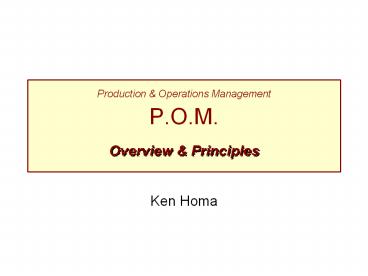Production PowerPoint PPT Presentation
1 / 26
Title: Production
1
Production Operations Management
P.O.M.Overview Principles
- Ken Homa
2
POM Overview
Decisions Actions
- Acquire deploy capacity
- Select, control improve processes
- Allocate schedule resources
Cost, Quality, Flexibility, Service
3
Capacity
- Acquire deploy capacity
- What? Facilities, equipment, people
- How much? Aggregate, dedicated
- When? Peak vs. average
- Where? Centralized / decentralized
- Owned by? Vertical / virtual integration
4
Capacity Performance Envelope
- From an organizational perspective
- Capacity decisions are big (usually
expensive) and defining for a company, I.e.
establish the performance envelope - Given the high cost, and normal
organizational inertia, capacity decisions are
often very difficult to undo, i.e. really are
quite fixed.
5
Capacity Timing
- From a strategic / financial perspective
- Add too much capacity too soon and short-run
profitability suffers. Add too little capacity
too late and market share constrained and
profit opportunities may be lost forever.
6
Capacity Additions
- (More) from a strategic / financial
perspective - Capacity is typically added in chunks e.g.
factories or factory lines. The first and last
chunks are the most critical. - Companies have natural tendency to start too
conservatively, to underestimate time to ramp
up, and to eventually overexpand. (Experiential
observation)
7
Capacity Location
- From a strategic / tactical perspective
- The location of capacity is often equally (or
more) important than sheer quantity. - Some locations are inherently more beneficial
than others, e.g. close to markets or economical
factor inputs.
8
Capacity Optimization
- (More) from a strategic / tactical perspective
- Locations (plants, distribution centers, etc)
are linked together into networks. - Network efficiency (global optimization) is
the paramount goal site efficiency (local
optimization) is supportive (secondary) and may
be sacrificed for the greater good.
9
Capacity Networks
- (More) from a strategic / tactical perspective
- Ownership is usually a legal detail and
financial impracticality, not necessarily a
strategic imperative. Allied networks (formal
virtual) of best providers are increasingly
prevalent.
10
Logical Physical Assets
- (More) from a strategic / tactical perspective
- Information (logical assets) moves faster and
is usually cheaper (after infrastructure is in
place) than physical assets (people, plants,
trucks, inventory, etc.). - Best operators support physical assets with
logical assets and substitute logical for
physical whenever possible.
11
Processes
- Acquire deploy capacity
- Select, control improve processes
- Linkages product / process design
- Orientation job shop, batch, flow
- Organization functional, cellular
- Metrics goals specifications
- Improvement incremental reengineered
12
Right Processes
- The right operations approach (process,
organization,etc.) is very situation-specific,
depending on market requirements, competitive
dynamics, and company competencies.
13
Product Process Design
- Product design and operations process
efficiency are inextricably linked. Operations
efficiency is ultimately limited by product
design for manufacturing.
14
Process Metrics
- Organizations are made up of well-intended
people (generally) who do what they understand,
what is measured, and what they get paid
for...So, performance measurements (metrics)
must be clear, aligned, quantified, and relevant
(to both the company the individual)
15
Quantified Metrics
More specifically All performance criteria
(metrics) can be quantified even (or
especially) quality. Trick transform
subjective variables into objective measurements
16
QFD
....
17
Process Improvement
- Process improvement can be incremental
(continuous improvement) and/or quantum-change
(reengineering). - Continuous improvement is (usually, bordering
on always) necessary but not (typically or
perpetually) sufficient! (Experiential
observation)
18
Process Success Factors
Bottomline re process Integrate product
process design Match approach to
situationMeasure, measure, measure Improve (or
perish)
19
Resources
- Acquire deploy capacity
- Select, control improve processes
- Allocate schedule resources
- Decision rules methods
- Variability predictability
- Facilitators inventory queues
20
Decision Rules Methods
- Decision rules (e.g. EOQs) and methods (e.g.
MRP, JIT) are the foundation tools of operations
that translate strategic intent into action and
performance.
21
Decision Rules
- The best decision rules and methods are
analytically-derived based on practical
statistics and mathematics.Most concepts are
straightforward (bordering on simple), but their
application is complicated by combinations,
permutations and level of detail.
22
Variability
Variability (I.e. peaks valleys) further
complicates the operations landscape.Variability
that is predictable can be mitigated with
buffers such as inventory and queues (I.e.
waiting lines)Unpredictable variability is the
mother of operations challenges.
23
Products Services
- What is the fundamental difference between a
product (manufacturing) business and a service
business?
24
Products Services
- What is the fundamental difference between a
product (manufacturing) business and a service
business?
Service businesses dont have inventory to
buffer mismatches of supply and demand though
queues (lines) provide some cushion peak
capacity is more relevant than average capacity
and effective resource scheduling is absolutely
critical
25
POM Overview
- Capacity Acquire deploy
- Processes Select, control improve
- Resources Allocate schedule
For efficiency productivity and to create a
competitive advantage ...
26
Competitive advantage CQFS
External (customer) Perspective
- Cost converted into price
- Quality augmented product on specs
- Flexibility broad line, fast change
- Service available when where needed
Quantifiable Winning Qualifying Ops Criteria

